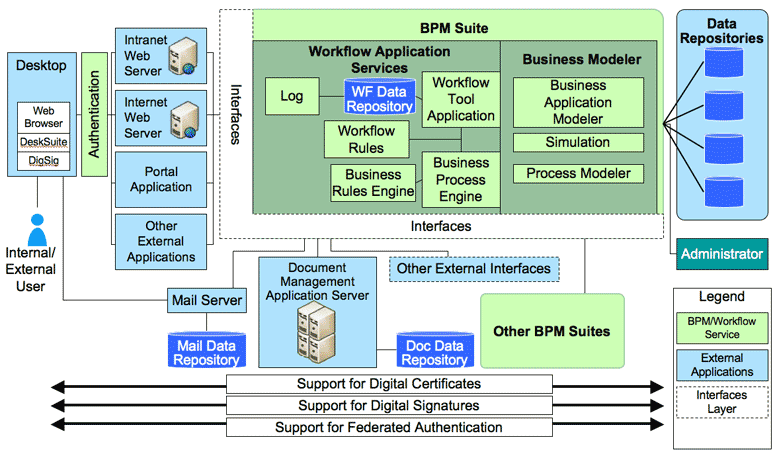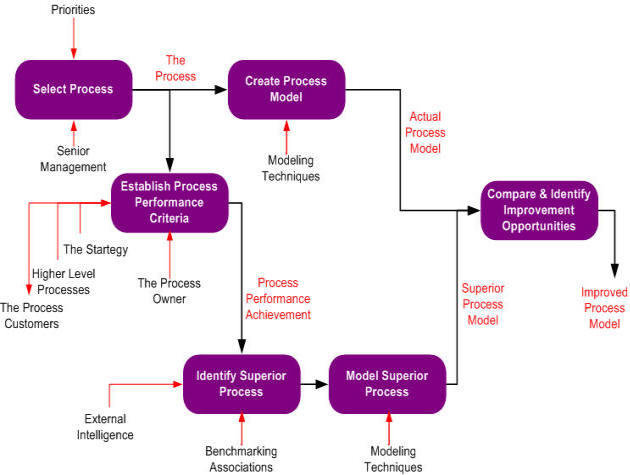Introduction
A few decades ago, many businesses experienced slow change or remained static due to poor management or non-visionary leadership practices. However, an enormous difference exists between the ancient and current business scenarios.
Contemporary organisations are characterised by tremendous changes due to continued innovation in the field of technology. This situation has ensured a neck-to-neck competition among various business entities.
Highly performing businesses have to adapt to the ever-shifting plans and processes that are implemented to capture new market niches.
Various changes in management orientations have led to emergence of practices such as Business Process Management (BPM), Business Process Reengineering (BPR), and Enterprise Integration (EI) among others.
This article reviews two organisational approaches that include Business Process Management and Business Process Reengineering by exploring their differences and benefits to modern enterprises.
Business Process Management (BPM) and Business Process Reengineering (BPR)
BPM is an approach that is systematically implemented in an enterprise to ensure improvement of all automated and non-automated processes. It plays a crucial role in linking together all the activities in the entity. For example, there must be a well-stipulated collaboration between the organisation, information technology, and staff.
This approach is accomplished to align the staff with varying business processes and information (Ryan, Stephen, & Wah 2009). In addition, BPM ensures that the enterprise is able to define, apply, and manage all its activities that pertain to interactions among employees and implementation of various types of applications.
This situation promotes efficient handling of the vast dynamic change procedures and processes (Ryan, Stephen, & Wah 2009).
Business process management must portray features that include modelling of methods that dictate the development and performance of various applications and integration of technologies.
For instance, the management of technological business processes demands deployment of competent personnel who can use the internet to retrieve data and display information with a view of maintaining efficient running of all processes in the organisation (Chen, Chiang, & Storey 2012; Ryan, Stephen, & Wah 2009).
BPM must also exhibit a thoroughgoing monitoring technique of various business activities. The reports of these activities must be shown promptly to ensure smooth and express flow of information (Chen, Chiang, & Storey 2012).
Most performing managers practice BPM through warranting effective re-designing, implementation, documentation, monitoring of activities, control, and measuring of any activities that are carried out.
Such managers also embrace flexibilities through the BPM cycle that includes vision, design, modelling, execution, monitoring, and optimising processes (Leymann, Roller, & Schmidt 2002). This situation ensures efficient implementation of change processes with a view of achieving organisational goals.
Various components that managers who practice BPM should consider include laying out robust platforms for modelling and implementing applications and business rules (process engineering). They should also apply proper business analysis with a view of identifying management issues, current trends, and opportunities.

Figure 1: showing sample Business Process Management with respect to Information Technology (Gulledge & Sommer 2002).
The reaction to such issues is paramount to the overall success of the organisation (Ravesteyn & Ronald 2010). Other components that have to be considered in BPM include proper handling and management of contents that pertain to proper documentation of company information.
However, modern businesses are highly advised to use electronic means for data storage. Lastly, the managers must embrace collaboration through minimisation of barriers that exist among the different departments (Ravesteyn & Ronald 2010).
The diagram above summarises how a BPM tool can be implemented in an organisation to improve its processes through integration of activities, systems, and personnel.
Business Process Reengineering
Redesigning the performance of activities in an organisation is termed as process reengineering. Many enterprises worldwide have implemented business process redesigning to suit organisational goals.
Therefore, Business Process Reengineering (BPR) is a rapid and radical change that involves restructuring various business processes or the whole enterprise with an aim of improving production, quality, and cycle time.
This process is initiated by the management through formulation of new strategies that are aimed at improving the value of the organisation to meet the consumer needs (Ryan, Stephen, & Wah 2009; Al-Mashari, Irani, & Zairi 2001).
The process of reengineering ensures that most of the unproductive aspects such as costly processes that are difficult to implement in production are eliminated. The approach encompasses the reorganisation of the operational aspects of the entity to come up with the relevant cross-functional processes.
It also includes the implementation of technology in data processing to improve communication and decision-making processes (Al-Mashari, Irani, & Zairi 2001).
However, BPR demands a proper lay out of activities that are in tandem with various factors that affect the operations of the enterprise. At the outset, a refocus must be ensured to include company values that are related to the needs of consumers.
Secondly, the processes must be redesigned using the relevant and current information technology systems to guarantee improved production and flow of activities. In addition, the business enterprise must be reshaped to capture the cross-functional and responsible teamwork based on end-to-end processes.
Other aspects that the designers must take into account include rethinking of issues that are related directly or indirectly to the organisation, workforce, and overall improvement of the business processes (Caron, Jarvenpaa, & Stoddard 1994).
Proper implementation of BPR ensures that enterprises reduce costs and cycle time. This state of affairs is achieved through redesigning the operational processes to get rid of unproductive processes and underperforming employees who implement such procedures (Caron, Jarvenpaa, & Stoddard 1994).
Various operational groups that exist in the organisation are rationalised in a way that is relevant to the required expertise to reduce aspects of management layers. This situation promotes the flow of information. It also ensures minimisation of errors during the production processes.
Other companies also practice business process reengineering to improve the quality of products through establishment of transparent and clear ownership of various organisational activities. This situation results in effective measurement of personnel performance due to efficient feedback.
Other reasons that compel business entities to embrace BPR include improving the competitive nature of the enterprise, expansion purposes, and urge to embrace current technology among others with a view of ensuring the continuance of the enterprise (Caron, Jarvenpaa, & Stoddard, 1994).

Figure 2: Sample flow chart of BPR in a company (Aguilar-Saven 2004).
Differences between BPM and BPR
Table 1: The table shows the differences between BPM and BPR.
Advantages of Business Process Management
The primary advantage of business process management is that it enables efficient planning and alignment of organisational functions to meet the needs of the consumers.
It also ensures that the executive management provides clear directions, monitors, and measures the available resources to improve production while minimising costs that are incurred in the process (Jennings, Norman, Faratin, O’Brien, & Odgers 2000).
Implementation of the BPM also results in the improved efficiency, minimisation of errors, transparency, and accountability of processes.
This state of affairs is achieved through proper monitoring of activities and expenditures. Accurate and timely information is crucial for the management of organisational processes since it promotes opportune formulation of production decisions (Jennings et al. 2000).
Another advantage of the BPM is its ability to ensure simplicity and adherence to regulations. This state of affairs is realised through maintenance of clear records that are in tandem with the government protocols concerning the operations of the entity.
The updated records ensure cost reductions that can be incurred due to non-compliance. There is also avoidance of wastages that are related to BPM. Regular performance of BPM promotes identification of errors, wastes, and areas that result in inefficiency (Trkman 2010). It also creates safer working conditions.
Finally yet importantly, the BPM enables the management to ensure improved production through frequent learning during the operations (Trkman 2010).
Summary of BPM and BPR
From the above detailed examination of the BPM and BPR, it can be concluded that the two processes are complement each other in the realisation of organisational targets. It is clear that implementation of BPR prompts the enterprise to change its vision, value, and mission.
Therefore, organisations should scrutinise this approach in depth to ensure that the risks that are involved in its execution are covered. BPR implementation also leads to restructuring of various critical aspects of the organisation such as the cooperate culture.
This approach is different from the BPM, which allows for flexibility. BPM deals with a few processes at a given time. Furthermore, there are no risks involved in implementing BPM. However, more expenses accompany the application of BPR; hence, it increases the operational risks (Leymann, Roller, & Schmidt 2002).
Conclusion
The article has critically examined BPM and BPR processes that affect the normal operations of any organisation upon their implementation. Nonetheless, it is realised that both of the operational processes are beneficial to the organisation since they are concerned with consumer needs.
The BPM technique is more advantageous because it requires less time and cost of implementation. In addition, the strategy does not interfere with the company’s corporate culture. Its outcome is also continuous. On the other hand, the business process reengineering is perceived as expensive and time-consuming.
Nonetheless, a drastic change in performance and outcome is always expected upon its application. Therefore, managers should focus on implementing the BPM since it does not interfere with the company’s culture.
However, enterprises that require an overhaul of their organisations, a BPR technique can be beneficial, especially when the company culture, location, and values are to be changed.
References
Aguilar-Saven, R 2004, ‘Business process modeling: Review and framework’, International Journal of production economics, vol. 90 no. 2, pp. 129-49.
Al-Mashari, M, Irani, Z & Zairi, M 2001, ‘Business process reengineering: a survey of international experience’, Business Process Management Journal, vol. 7 no. 5, pp. 437-55.
Caron, J, Jarvenpaa, S & Stoddard, D 1994, ‘Business reengineering at CIGNA Corporation: experiences and lessons learned from the first five years’, Mis Quarterly, vol. 18 no. 3, pp. 233-50.
Gulledge Jr, T & Sommer, R 2002, ‘Business process management: public sector implications’, Business Process Management Journal, vol. 8 no. 4, pp. 364-76.
Jennings, N, Norman, T, Faratin, P, O’Brien, P & Odgers, B 2000, ‘Autonomous agents for business process management’, Applied Artificial Intelligence, vol. 14 no. 2, pp. 145-189.
Ko, R, Lee, S & Lee, E 2009, ‘Business process management (BPM) standards: a survey’, Business Process Management Journal, vol. 15 no. 5, pp. 744-91.
Leymann, F, Roller, D & Schmidt, M 2002, ‘Web services and business process management’, IBM systems Journal, vol. 41 no. 2, pp. 198-211.
Ravesteyn, P & Batenburg, R 2010, ‘Surveying the critical success factors of BPM-systems implementation’, Business Process Management Journal, vol. 16 no. 3, pp. 492-507.
Trkman, P 2010, ‘The critical success factors of business process management’, International Journal of Information Management, vol. 30 no. 2, pp. 125-34.